We love our lupines, paintbrushes, and saxifrage flowers—but there is a truly stunning plant I get the feeling most of Whistler’s trail-traversing folk have not yet laid their eyeballs on. Personally, I think it’s a tiny tragedy this plant exists in our landscapes without the admiration it deserves. After multiple instances of introducing this plant to locals who at first didn’t believe such a plant lives here, I am compelled to give it a proper spotlight.
The spotlighted plant today is Capnoides sempervirens, also called pale (or pink) corydalis. Corydalis is the old, but still often used genus name. These common names don’t do justice to its visual flamboyance. It’s giving part lupine, part bleeding heart, part cotton candy. But the common name I know this plant by is rock harlequin, which will make sense shortly.
Let’s start my introduction of the C. sempervirens with the general habitat type. It likes dry woods and rocky ledges, which tend to provide an open canopy with a good view of the sky. So it thrives in the kinds of conditions we moisture-loving southwest B.C. folks would call poor and dry—but that’s exactly what it loves.
To learn to recognize a plant requires a little breakdown of its morphology. C. sempervirens is a biennial plant that starts with a basal rosette in its first year, then grows branched stems topped with drooping pink and yellow tubular flowers in its second year. These colourful flowers eventually turn into long, narrow seed pods that split open to release small, shiny black seeds. Its bluish-green leaves are compound—made up of multiple small, finely divided leaflets. She’s tall and lanky like Columbia lilies (Lilium columbianum) or Western columbine (Aquilegia formosa), swaying tall at 20 to 80 centimetres in height.
So it thrives in exposed, summer-baked rocky trail sections, hence the rock portion of its name, plus harlequin, meaning varied colours or clown-like—so voila, the rock harlequin!
Its uniqueness amongst our other native wildflowers is illustrated further by the fact it is the only species in the Capnoides genus. This may sound boring to most, but essentially, it has no close relatives alive today. It’s like being the last branch on a family tree—there are no siblings or cousins that share some of its traits. This means it likely has unique characteristics or survival strategies that are different from those of any other species. If such a species were to disappear, say, due to the current climate crisis, we wouldn’t just lose one plant—we would lose an entire evolutionary twig.
So, you might be asking, “Great, now where can I find this thing?” At this time of the year, in Whistler, look around the rock outcrops in Emerald Estates or north of Lost Lake. Elsewhere, north of Shadow Lake on either side of Highway 99, around Nairn Falls Provincial Park, in the Lower Mackenzie trails in Pemberton, and in Squamish on the trails around Brohm Lake and Smoke Bluffs Park.
If you haven’t learned to recognize a new local plant in a while, consider starting with the sorbet-coloured, sun-soaking rock harlequin. Then next summer, choose another one—you’ve got nearly 700 native vascular plants to choose from!
Naturespeak is prepared by the Whistler Naturalists. To learn more about Whistler’s natural world, go to whistlernaturalists.ca.




